2014 BMW 650I COUPE tow
[x] Cancel search: towPage 193 of 237
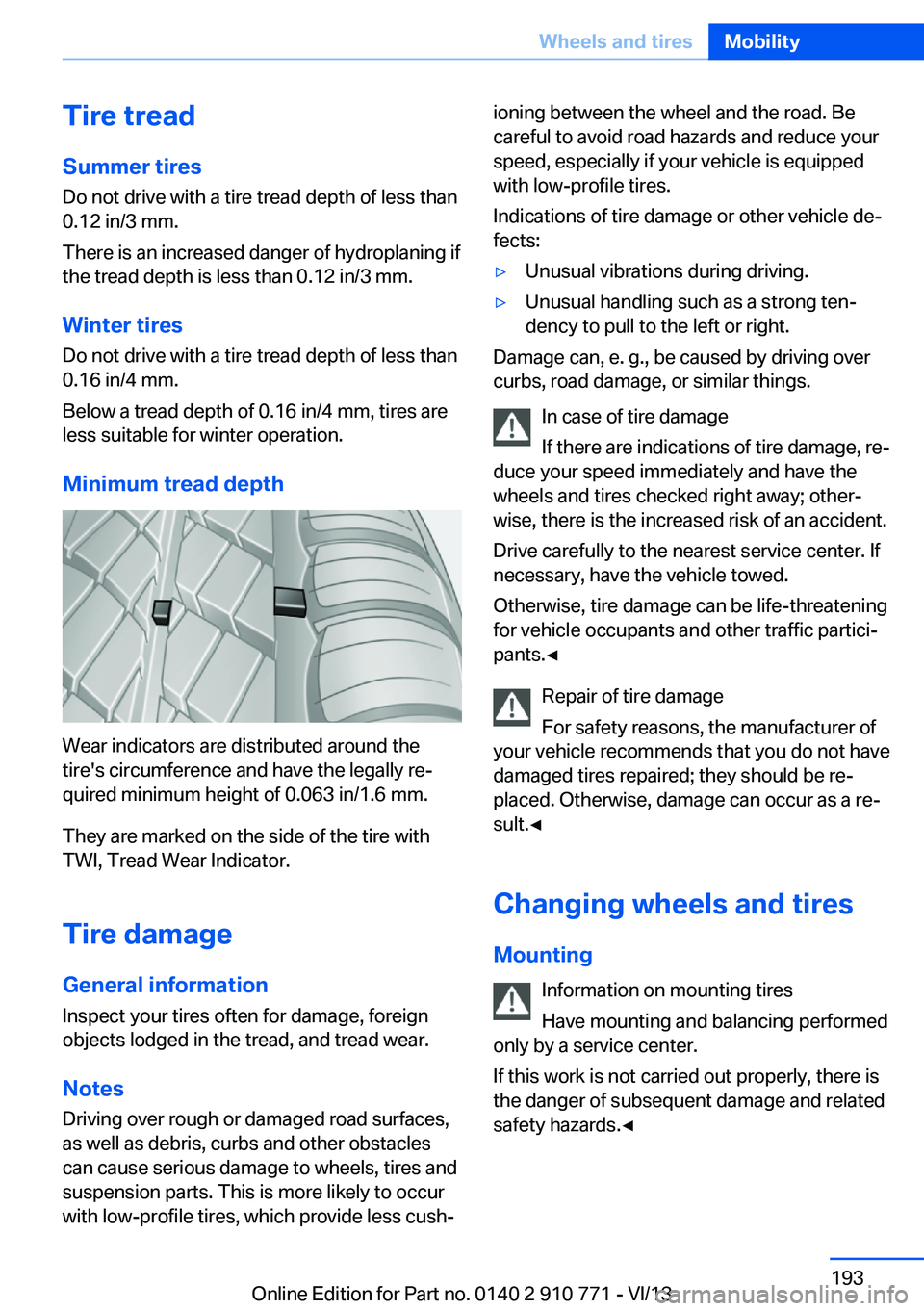
Tire treadSummer tires
Do not drive with a tire tread depth of less than
0.12 in/3 mm.
There is an increased danger of hydroplaning if
the tread depth is less than 0.12 in/3 mm.
Winter tires Do not drive with a tire tread depth of less than
0.16 in/4 mm.
Below a tread depth of 0.16 in/4 mm, tires are
less suitable for winter operation.
Minimum tread depth
Wear indicators are distributed around the
tire's circumference and have the legally re‐
quired minimum height of 0.063 in/1.6 mm.
They are marked on the side of the tire with
TWI, Tread Wear Indicator.
Tire damage
General information
Inspect your tires often for damage, foreign
objects lodged in the tread, and tread wear.
Notes
Driving over rough or damaged road surfaces,
as well as debris, curbs and other obstacles can cause serious damage to wheels, tires and
suspension parts. This is more likely to occur
with low-profile tires, which provide less cush‐
ioning between the wheel and the road. Be
careful to avoid road hazards and reduce your
speed, especially if your vehicle is equipped
with low-profile tires.
Indications of tire damage or other vehicle de‐
fects:▷Unusual vibrations during driving.▷Unusual handling such as a strong ten‐
dency to pull to the left or right.
Damage can, e. g., be caused by driving over
curbs, road damage, or similar things.
In case of tire damage
If there are indications of tire damage, re‐
duce your speed immediately and have the
wheels and tires checked right away; other‐
wise, there is the increased risk of an accident.
Drive carefully to the nearest service center. If
necessary, have the vehicle towed.
Otherwise, tire damage can be life-threatening
for vehicle occupants and other traffic partici‐
pants.◀
Repair of tire damage
For safety reasons, the manufacturer of
your vehicle recommends that you do not have
damaged tires repaired; they should be re‐
placed. Otherwise, damage can occur as a re‐
sult.◀
Changing wheels and tires
Mounting Information on mounting tires
Have mounting and balancing performed
only by a service center.
If this work is not carried out properly, there is
the danger of subsequent damage and related
safety hazards.◀
Seite 193Wheels and tiresMobility193
Online Edition for Part no. 0140 2 910 771 - VI/13
Page 201 of 237
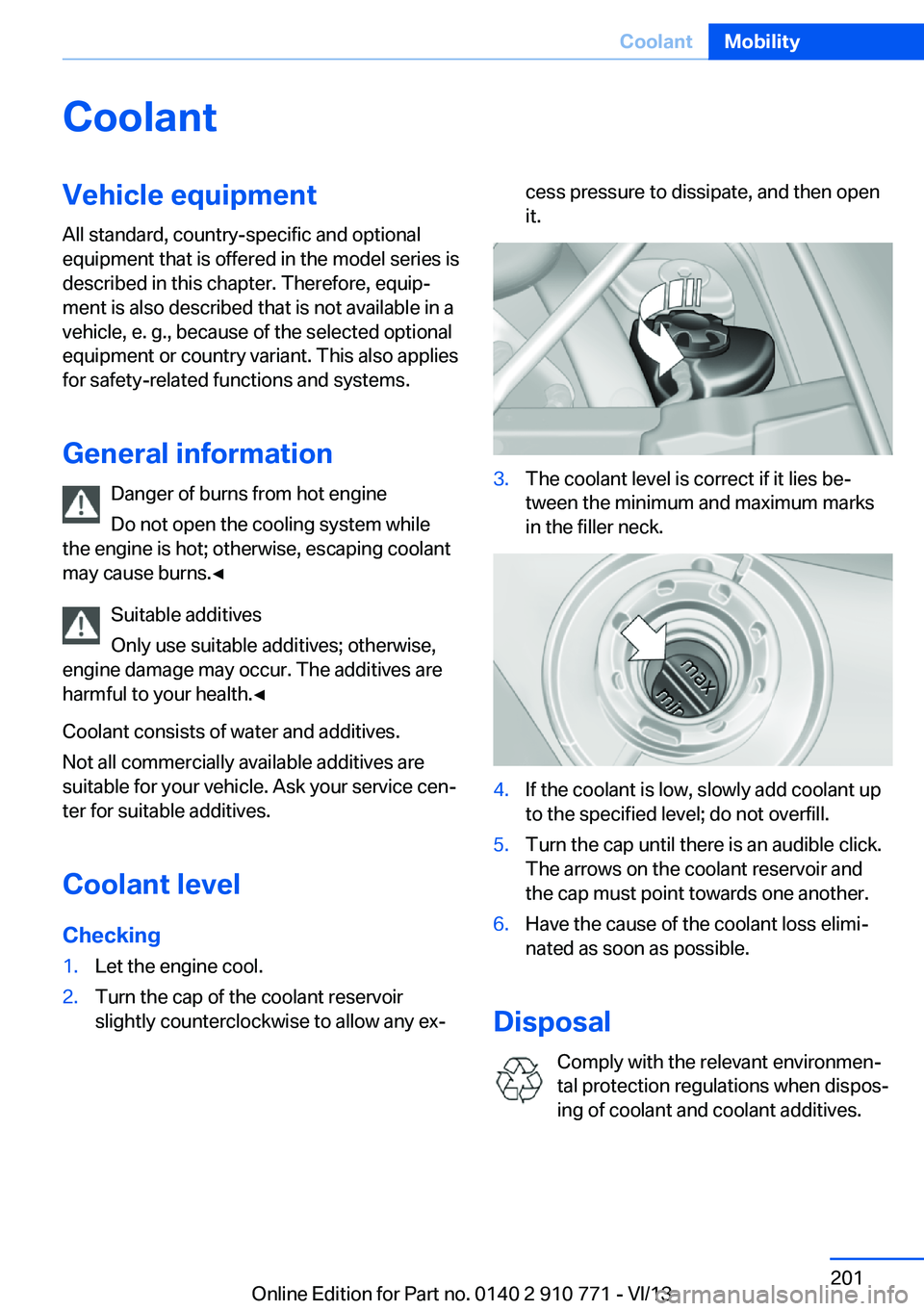
CoolantVehicle equipmentAll standard, country-specific and optional
equipment that is offered in the model series is
described in this chapter. Therefore, equip‐
ment is also described that is not available in a
vehicle, e. g., because of the selected optional
equipment or country variant. This also applies
for safety-related functions and systems.
General information Danger of burns from hot engine
Do not open the cooling system while
the engine is hot; otherwise, escaping coolant may cause burns.◀
Suitable additives
Only use suitable additives; otherwise,
engine damage may occur. The additives are
harmful to your health.◀
Coolant consists of water and additives.
Not all commercially available additives are
suitable for your vehicle. Ask your service cen‐
ter for suitable additives.
Coolant level
Checking1.Let the engine cool.2.Turn the cap of the coolant reservoir
slightly counterclockwise to allow any ex‐cess pressure to dissipate, and then open
it.3.The coolant level is correct if it lies be‐
tween the minimum and maximum marks
in the filler neck.4.If the coolant is low, slowly add coolant up
to the specified level; do not overfill.5.Turn the cap until there is an audible click.
The arrows on the coolant reservoir and
the cap must point towards one another.6.Have the cause of the coolant loss elimi‐
nated as soon as possible.
Disposal
Comply with the relevant environmen‐
tal protection regulations when dispos‐
ing of coolant and coolant additives.
Seite 201CoolantMobility201
Online Edition for Part no. 0140 2 910 771 - VI/13
Page 204 of 237
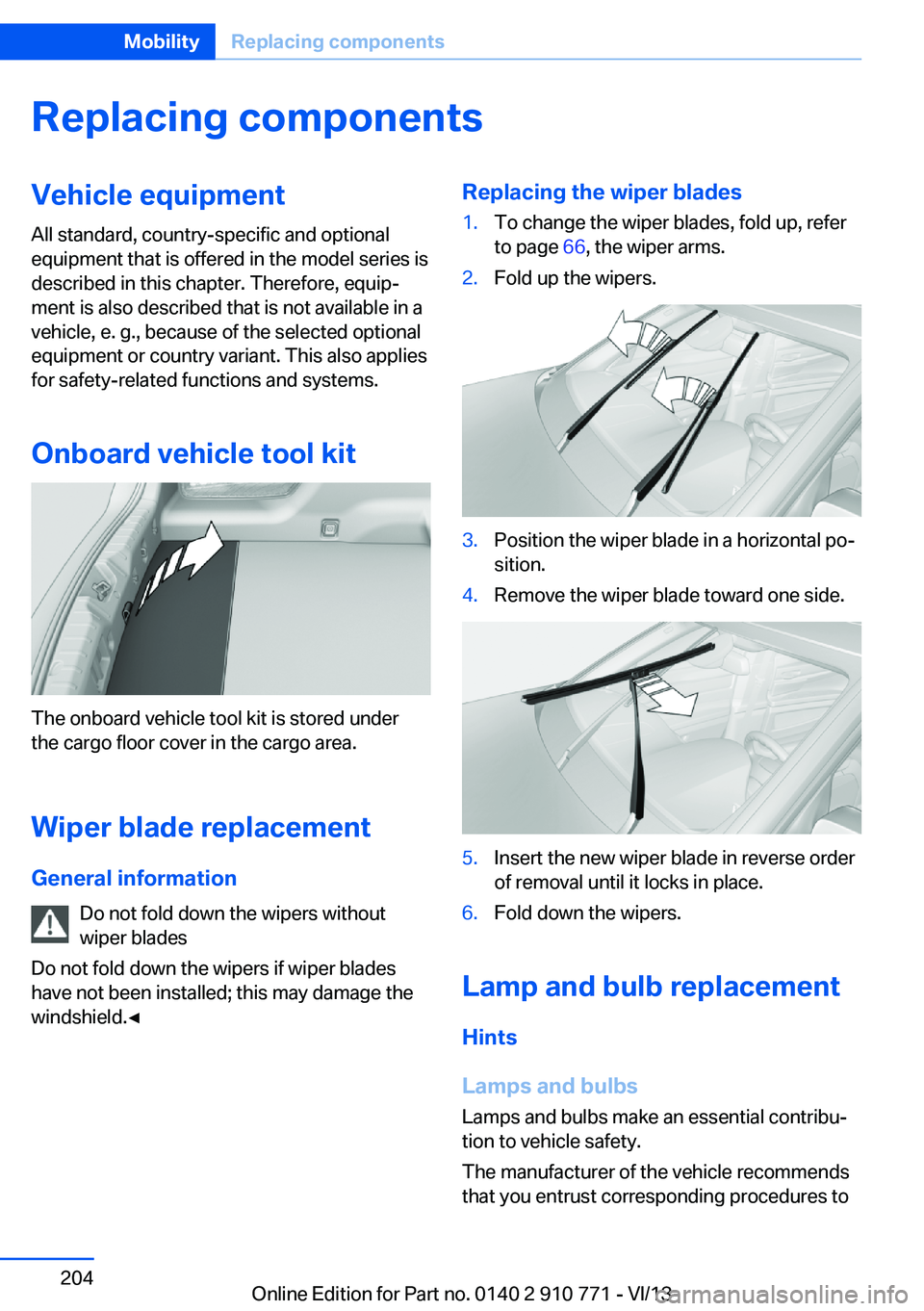
Replacing componentsVehicle equipmentAll standard, country-specific and optional
equipment that is offered in the model series is
described in this chapter. Therefore, equip‐
ment is also described that is not available in a
vehicle, e. g., because of the selected optional
equipment or country variant. This also applies
for safety-related functions and systems.
Onboard vehicle tool kit
The onboard vehicle tool kit is stored under
the cargo floor cover in the cargo area.
Wiper blade replacement
General information Do not fold down the wipers without
wiper blades
Do not fold down the wipers if wiper blades
have not been installed; this may damage the
windshield.◀
Replacing the wiper blades1.To change the wiper blades, fold up, refer
to page 66, the wiper arms.2.Fold up the wipers.3.Position the wiper blade in a horizontal po‐
sition.4.Remove the wiper blade toward one side.5.Insert the new wiper blade in reverse order
of removal until it locks in place.6.Fold down the wipers.
Lamp and bulb replacement
Hints
Lamps and bulbs
Lamps and bulbs make an essential contribu‐
tion to vehicle safety.
The manufacturer of the vehicle recommends
that you entrust corresponding procedures to
Seite 204MobilityReplacing components204
Online Edition for Part no. 0140 2 910 771 - VI/13
Page 213 of 237
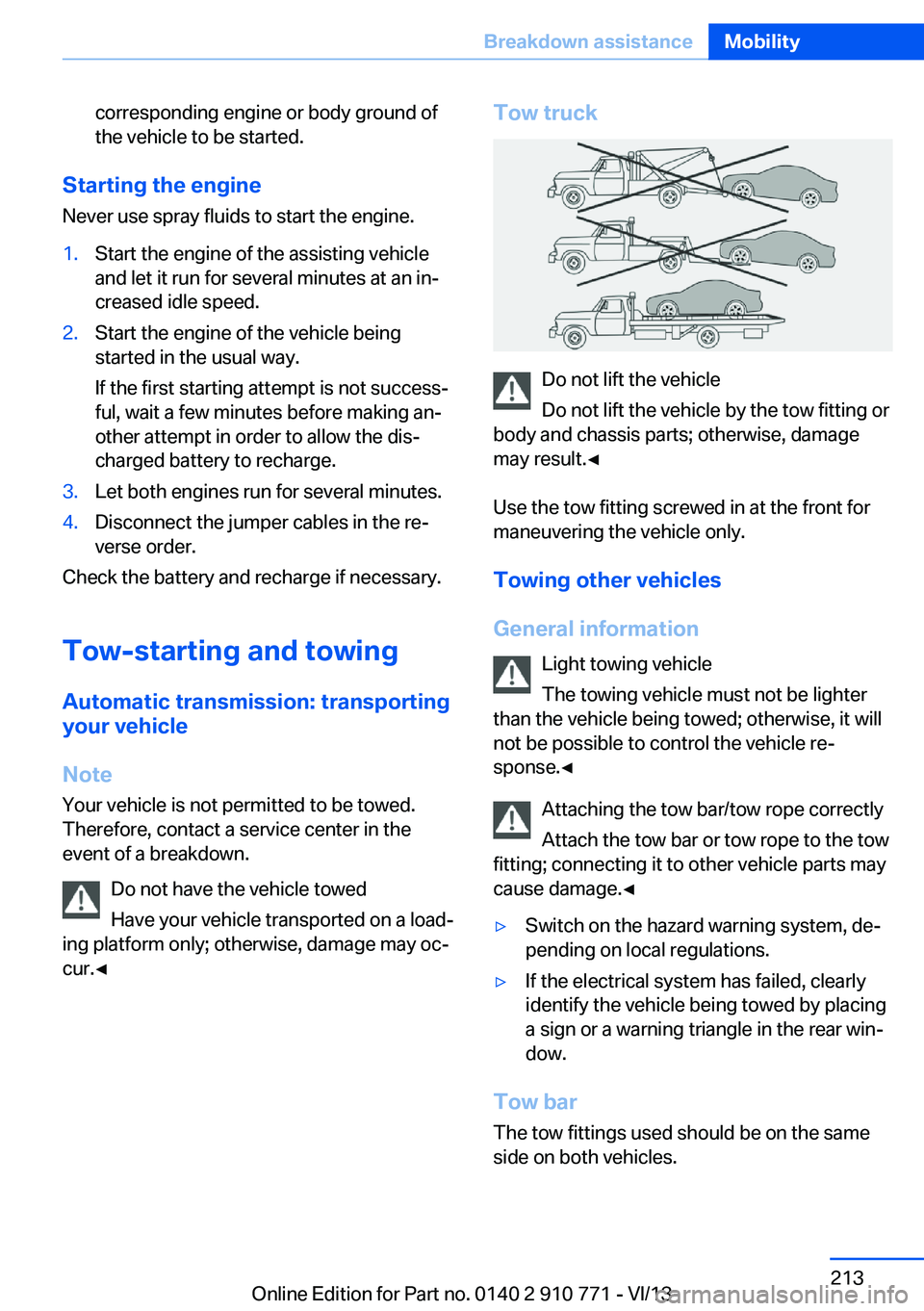
corresponding engine or body ground of
the vehicle to be started.
Starting the engine
Never use spray fluids to start the engine.
1.Start the engine of the assisting vehicle
and let it run for several minutes at an in‐
creased idle speed.2.Start the engine of the vehicle being
started in the usual way.
If the first starting attempt is not success‐
ful, wait a few minutes before making an‐
other attempt in order to allow the dis‐
charged battery to recharge.3.Let both engines run for several minutes.4.Disconnect the jumper cables in the re‐
verse order.
Check the battery and recharge if necessary.
Tow-starting and towing Automatic transmission: transporting
your vehicle
Note
Your vehicle is not permitted to be towed.
Therefore, contact a service center in the
event of a breakdown.
Do not have the vehicle towed
Have your vehicle transported on a load‐
ing platform only; otherwise, damage may oc‐
cur.◀
Tow truck
Do not lift the vehicle
Do not lift the vehicle by the tow fitting or
body and chassis parts; otherwise, damage
may result.◀
Use the tow fitting screwed in at the front for
maneuvering the vehicle only.
Towing other vehicles
General information Light towing vehicle
The towing vehicle must not be lighter
than the vehicle being towed; otherwise, it will
not be possible to control the vehicle re‐
sponse.◀
Attaching the tow bar/tow rope correctly
Attach the tow bar or tow rope to the tow
fitting; connecting it to other vehicle parts may
cause damage.◀
▷Switch on the hazard warning system, de‐
pending on local regulations.▷If the electrical system has failed, clearly
identify the vehicle being towed by placing
a sign or a warning triangle in the rear win‐
dow.
Tow bar
The tow fittings used should be on the same
side on both vehicles.
Seite 213Breakdown assistanceMobility213
Online Edition for Part no. 0140 2 910 771 - VI/13
Page 214 of 237
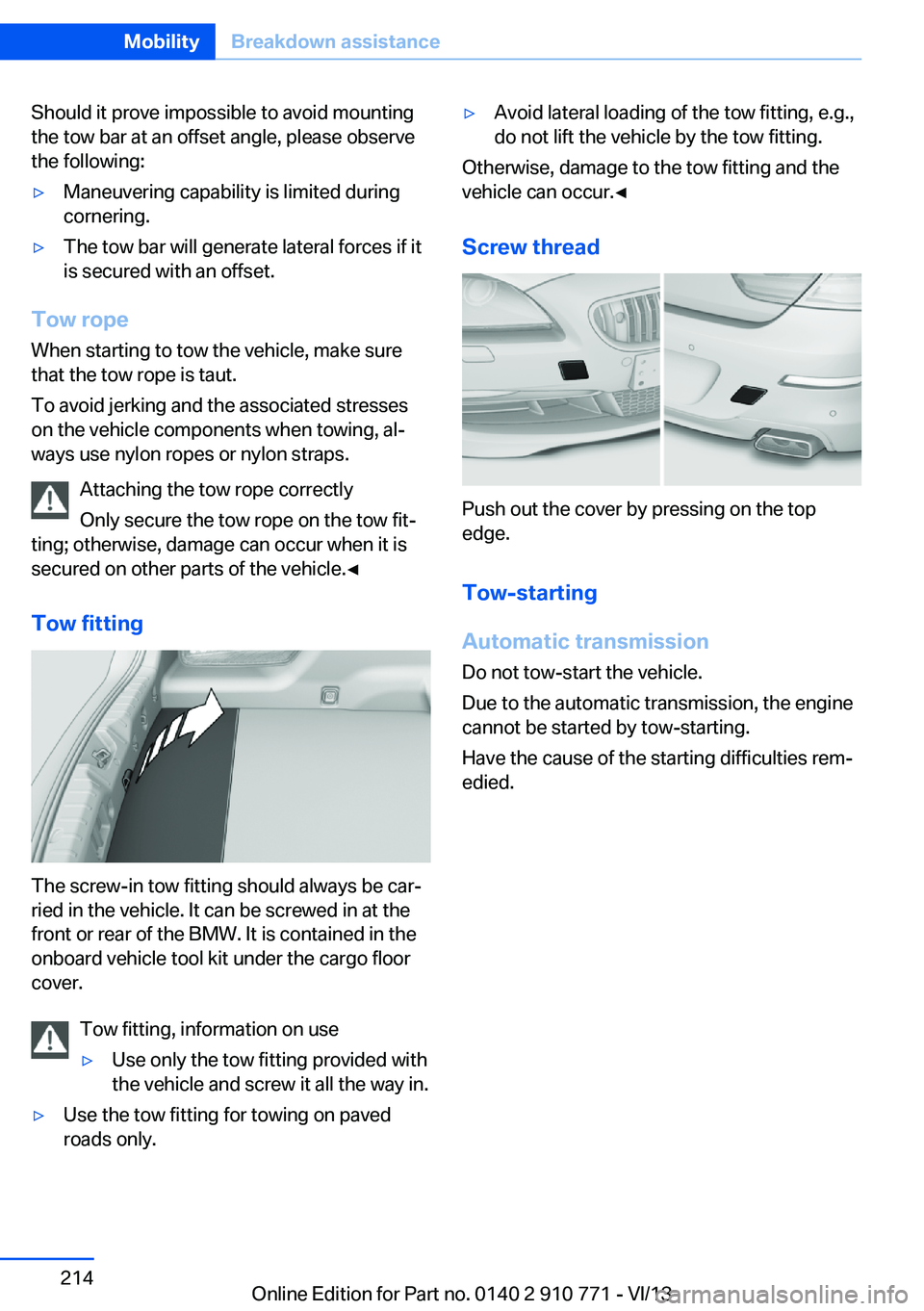
Should it prove impossible to avoid mounting
the tow bar at an offset angle, please observe
the following:▷Maneuvering capability is limited during
cornering.▷The tow bar will generate lateral forces if it
is secured with an offset.
Tow rope
When starting to tow the vehicle, make sure
that the tow rope is taut.
To avoid jerking and the associated stresses
on the vehicle components when towing, al‐
ways use nylon ropes or nylon straps.
Attaching the tow rope correctly
Only secure the tow rope on the tow fit‐
ting; otherwise, damage can occur when it is
secured on other parts of the vehicle.◀
Tow fitting
The screw-in tow fitting should always be car‐
ried in the vehicle. It can be screwed in at the
front or rear of the BMW. It is contained in the
onboard vehicle tool kit under the cargo floor
cover.
Tow fitting, information on use
▷Use only the tow fitting provided with
the vehicle and screw it all the way in.▷Use the tow fitting for towing on paved
roads only.▷Avoid lateral loading of the tow fitting, e.g.,
do not lift the vehicle by the tow fitting.
Otherwise, damage to the tow fitting and the
vehicle can occur.◀
Screw thread
Push out the cover by pressing on the top
edge.
Tow-starting
Automatic transmission Do not tow-start the vehicle.
Due to the automatic transmission, the engine
cannot be started by tow-starting.
Have the cause of the starting difficulties rem‐
edied.
Seite 214MobilityBreakdown assistance214
Online Edition for Part no. 0140 2 910 771 - VI/13
Page 226 of 237
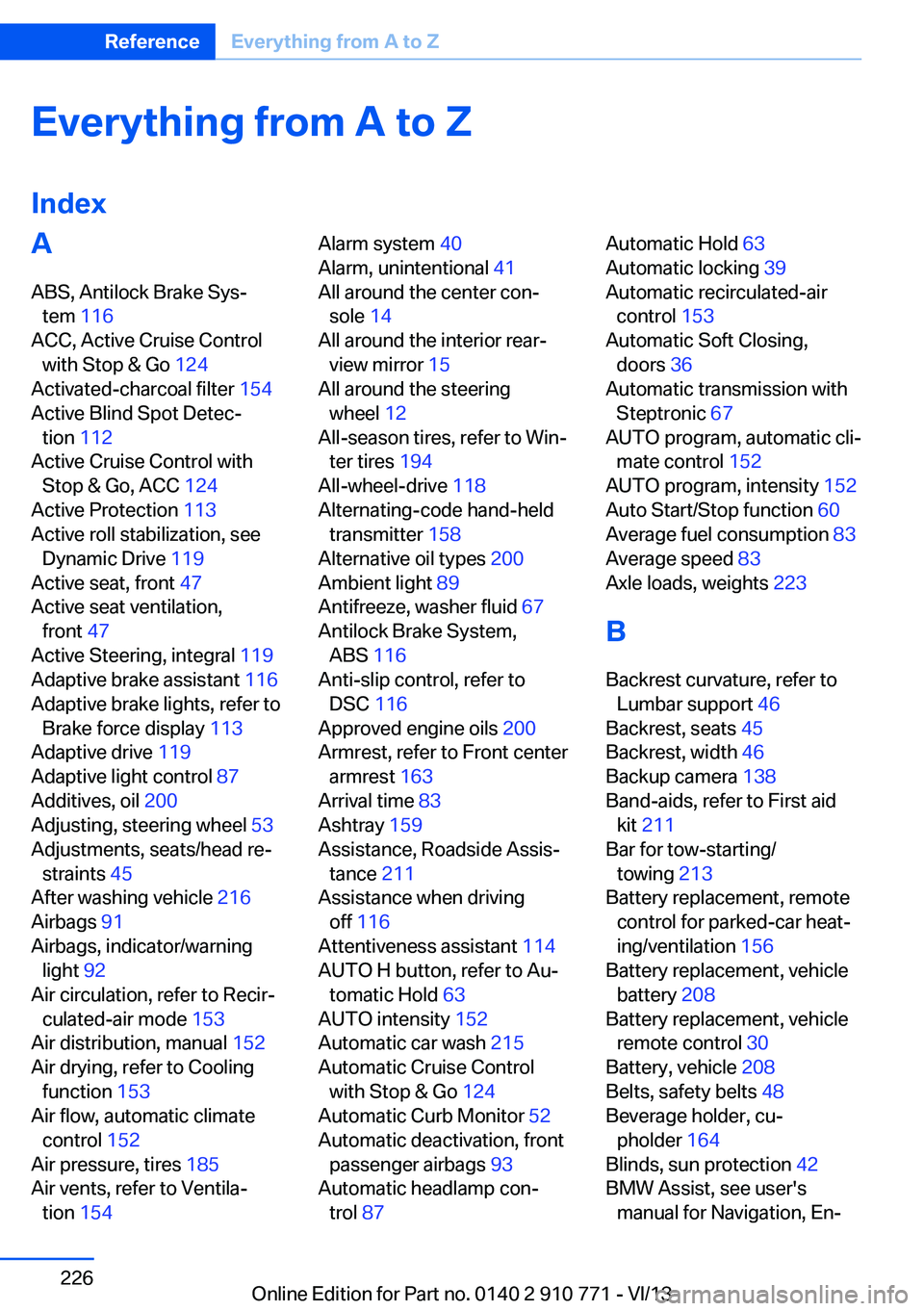
Everything from A to Z
IndexA ABS, Antilock Brake Sys‐ tem 116
ACC, Active Cruise Control with Stop & Go 124
Activated-charcoal filter 154
Active Blind Spot Detec‐ tion 112
Active Cruise Control with Stop & Go, ACC 124
Active Protection 113
Active roll stabilization, see Dynamic Drive 119
Active seat, front 47
Active seat ventilation, front 47
Active Steering, integral 119
Adaptive brake assistant 116
Adaptive brake lights, refer to Brake force display 113
Adaptive drive 119
Adaptive light control 87
Additives, oil 200
Adjusting, steering wheel 53
Adjustments, seats/head re‐ straints 45
After washing vehicle 216
Airbags 91
Airbags, indicator/warning light 92
Air circulation, refer to Recir‐ culated-air mode 153
Air distribution, manual 152
Air drying, refer to Cooling function 153
Air flow, automatic climate control 152
Air pressure, tires 185
Air vents, refer to Ventila‐ tion 154 Alarm system 40
Alarm, unintentional 41
All around the center con‐ sole 14
All around the interior rear‐ view mirror 15
All around the steering wheel 12
All-season tires, refer to Win‐ ter tires 194
All-wheel-drive 118
Alternating-code hand-held transmitter 158
Alternative oil types 200
Ambient light 89
Antifreeze, washer fluid 67
Antilock Brake System, ABS 116
Anti-slip control, refer to DSC 116
Approved engine oils 200
Armrest, refer to Front center armrest 163
Arrival time 83
Ashtray 159
Assistance, Roadside Assis‐ tance 211
Assistance when driving off 116
Attentiveness assistant 114
AUTO H button, refer to Au‐ tomatic Hold 63
AUTO intensity 152
Automatic car wash 215
Automatic Cruise Control with Stop & Go 124
Automatic Curb Monitor 52
Automatic deactivation, front passenger airbags 93
Automatic headlamp con‐ trol 87 Automatic Hold 63
Automatic locking 39
Automatic recirculated-air control 153
Automatic Soft Closing, doors 36
Automatic transmission with Steptronic 67
AUTO program, automatic cli‐ mate control 152
AUTO program, intensity 152
Auto Start/Stop function 60
Average fuel consumption 83
Average speed 83
Axle loads, weights 223
B Backrest curvature, refer to Lumbar support 46
Backrest, seats 45
Backrest, width 46
Backup camera 138
Band-aids, refer to First aid kit 211
Bar for tow-starting/ towing 213
Battery replacement, remote control for parked-car heat‐
ing/ventilation 156
Battery replacement, vehicle battery 208
Battery replacement, vehicle remote control 30
Battery, vehicle 208
Belts, safety belts 48
Beverage holder, cu‐ pholder 164
Blinds, sun protection 42
BMW Assist, see user's manual for Navigation, En‐Seite 226ReferenceEverything from A to Z226
Online Edition for Part no. 0140 2 910 771 - VI/13
Page 229 of 237
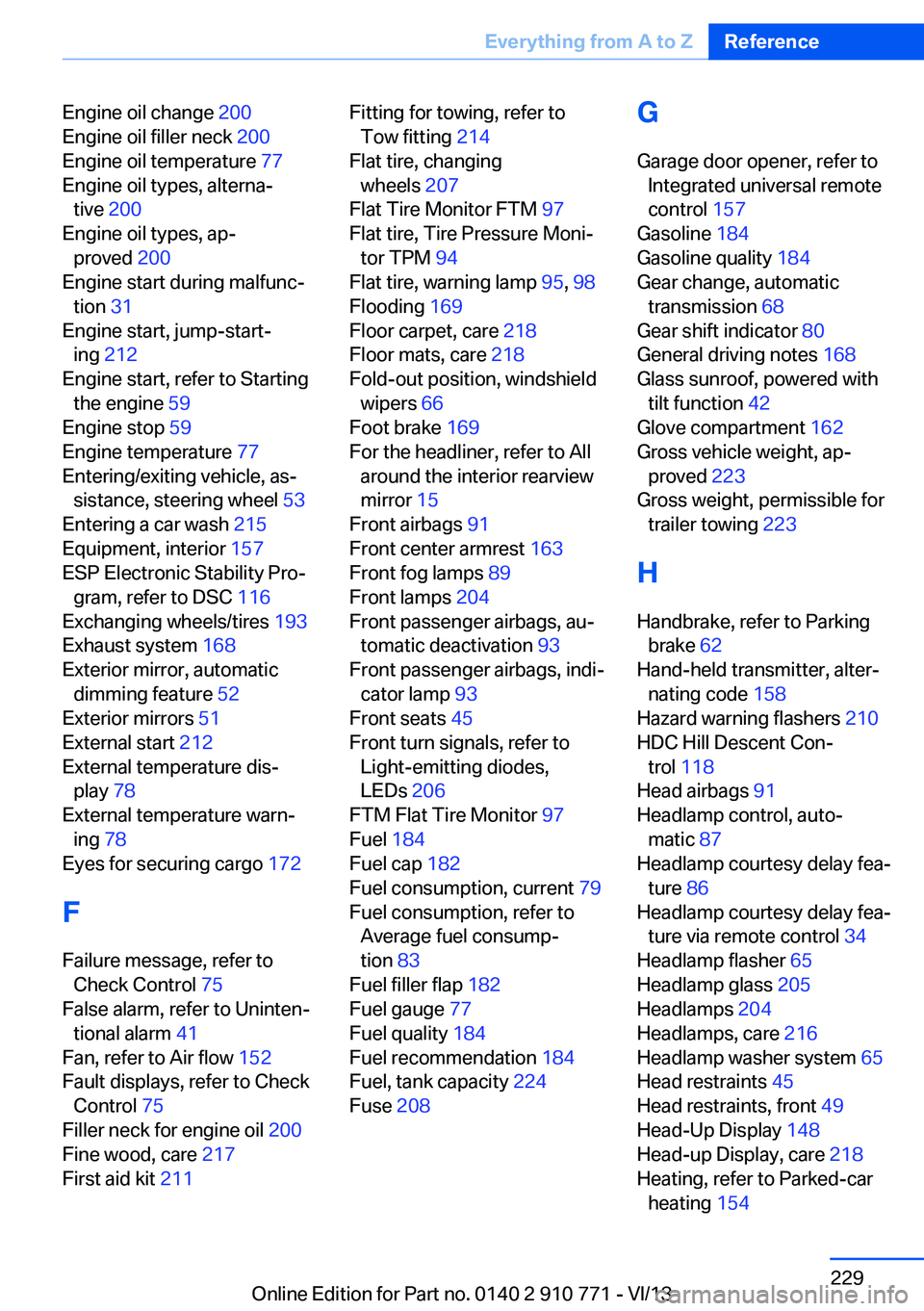
Engine oil change 200
Engine oil filler neck 200
Engine oil temperature 77
Engine oil types, alterna‐ tive 200
Engine oil types, ap‐ proved 200
Engine start during malfunc‐ tion 31
Engine start, jump-start‐ ing 212
Engine start, refer to Starting the engine 59
Engine stop 59
Engine temperature 77
Entering/exiting vehicle, as‐ sistance, steering wheel 53
Entering a car wash 215
Equipment, interior 157
ESP Electronic Stability Pro‐ gram, refer to DSC 116
Exchanging wheels/tires 193
Exhaust system 168
Exterior mirror, automatic dimming feature 52
Exterior mirrors 51
External start 212
External temperature dis‐ play 78
External temperature warn‐ ing 78
Eyes for securing cargo 172
F
Failure message, refer to Check Control 75
False alarm, refer to Uninten‐ tional alarm 41
Fan, refer to Air flow 152
Fault displays, refer to Check Control 75
Filler neck for engine oil 200
Fine wood, care 217
First aid kit 211 Fitting for towing, refer to
Tow fitting 214
Flat tire, changing wheels 207
Flat Tire Monitor FTM 97
Flat tire, Tire Pressure Moni‐ tor TPM 94
Flat tire, warning lamp 95, 98
Flooding 169
Floor carpet, care 218
Floor mats, care 218
Fold-out position, windshield wipers 66
Foot brake 169
For the headliner, refer to All around the interior rearview
mirror 15
Front airbags 91
Front center armrest 163
Front fog lamps 89
Front lamps 204
Front passenger airbags, au‐ tomatic deactivation 93
Front passenger airbags, indi‐ cator lamp 93
Front seats 45
Front turn signals, refer to Light-emitting diodes,
LEDs 206
FTM Flat Tire Monitor 97
Fuel 184
Fuel cap 182
Fuel consumption, current 79
Fuel consumption, refer to Average fuel consump‐
tion 83
Fuel filler flap 182
Fuel gauge 77
Fuel quality 184
Fuel recommendation 184
Fuel, tank capacity 224
Fuse 208 G
Garage door opener, refer to Integrated universal remote
control 157
Gasoline 184
Gasoline quality 184
Gear change, automatic transmission 68
Gear shift indicator 80
General driving notes 168
Glass sunroof, powered with tilt function 42
Glove compartment 162
Gross vehicle weight, ap‐ proved 223
Gross weight, permissible for trailer towing 223
H
Handbrake, refer to Parking brake 62
Hand-held transmitter, alter‐ nating code 158
Hazard warning flashers 210
HDC Hill Descent Con‐ trol 118
Head airbags 91
Headlamp control, auto‐ matic 87
Headlamp courtesy delay fea‐ ture 86
Headlamp courtesy delay fea‐ ture via remote control 34
Headlamp flasher 65
Headlamp glass 205
Headlamps 204
Headlamps, care 216
Headlamp washer system 65
Head restraints 45
Head restraints, front 49
Head-Up Display 148
Head-up Display, care 218
Heating, refer to Parked-car heating 154 Seite 229Everything from A to ZReference229
Online Edition for Part no. 0140 2 910 771 - VI/13
Page 230 of 237
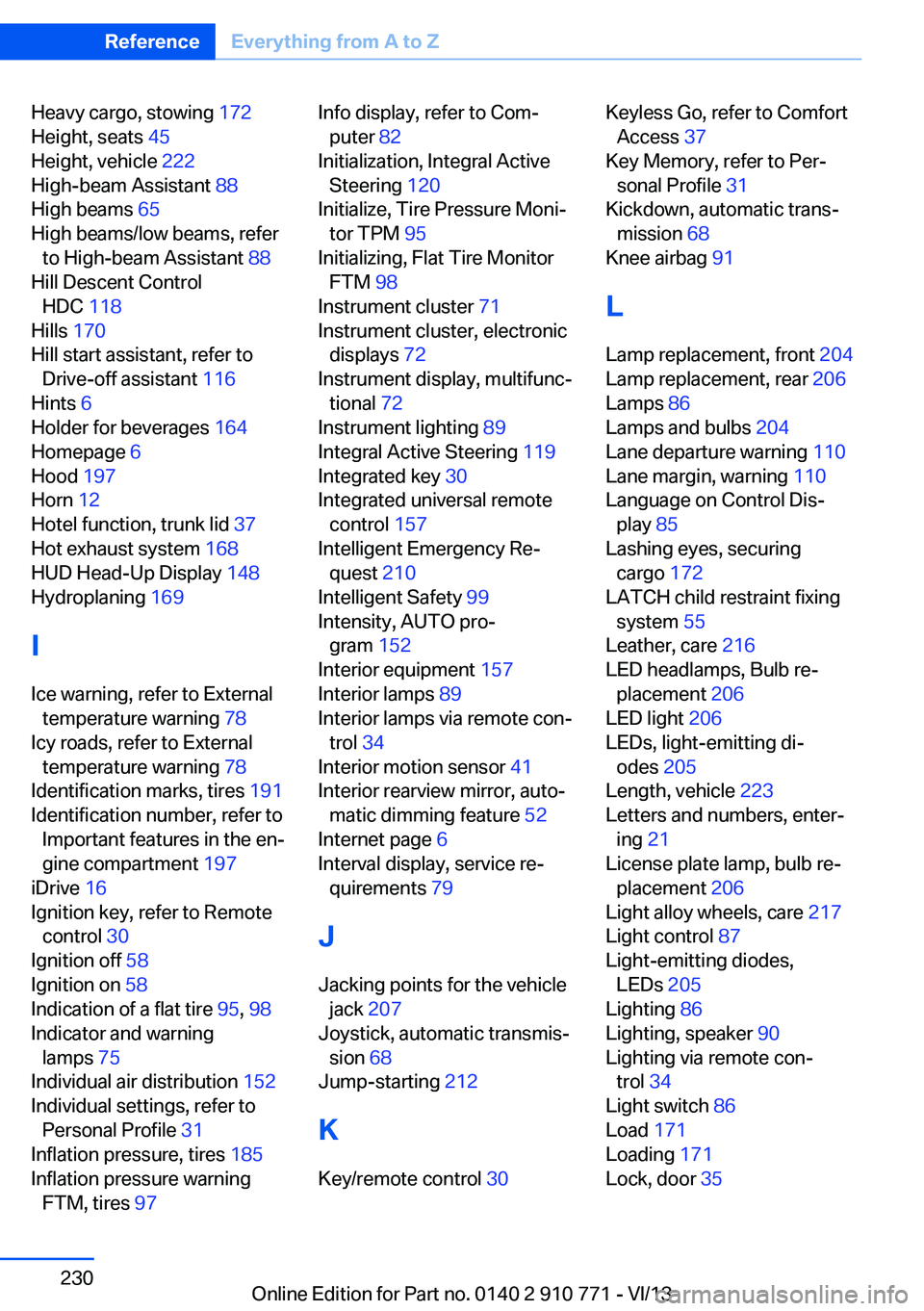
Heavy cargo, stowing 172
Height, seats 45
Height, vehicle 222
High-beam Assistant 88
High beams 65
High beams/low beams, refer to High-beam Assistant 88
Hill Descent Control HDC 118
Hills 170
Hill start assistant, refer to Drive-off assistant 116
Hints 6
Holder for beverages 164
Homepage 6
Hood 197
Horn 12
Hotel function, trunk lid 37
Hot exhaust system 168
HUD Head-Up Display 148
Hydroplaning 169
I Ice warning, refer to External temperature warning 78
Icy roads, refer to External temperature warning 78
Identification marks, tires 191
Identification number, refer to Important features in the en‐
gine compartment 197
iDrive 16
Ignition key, refer to Remote control 30
Ignition off 58
Ignition on 58
Indication of a flat tire 95, 98
Indicator and warning lamps 75
Individual air distribution 152
Individual settings, refer to Personal Profile 31
Inflation pressure, tires 185
Inflation pressure warning FTM, tires 97 Info display, refer to Com‐
puter 82
Initialization, Integral Active Steering 120
Initialize, Tire Pressure Moni‐ tor TPM 95
Initializing, Flat Tire Monitor FTM 98
Instrument cluster 71
Instrument cluster, electronic displays 72
Instrument display, multifunc‐ tional 72
Instrument lighting 89
Integral Active Steering 119
Integrated key 30
Integrated universal remote control 157
Intelligent Emergency Re‐ quest 210
Intelligent Safety 99
Intensity, AUTO pro‐ gram 152
Interior equipment 157
Interior lamps 89
Interior lamps via remote con‐ trol 34
Interior motion sensor 41
Interior rearview mirror, auto‐ matic dimming feature 52
Internet page 6
Interval display, service re‐ quirements 79
J Jacking points for the vehicle jack 207
Joystick, automatic transmis‐ sion 68
Jump-starting 212
K
Key/remote control 30 Keyless Go, refer to Comfort
Access 37
Key Memory, refer to Per‐ sonal Profile 31
Kickdown, automatic trans‐ mission 68
Knee airbag 91
L Lamp replacement, front 204
Lamp replacement, rear 206
Lamps 86
Lamps and bulbs 204
Lane departure warning 110
Lane margin, warning 110
Language on Control Dis‐ play 85
Lashing eyes, securing cargo 172
LATCH child restraint fixing system 55
Leather, care 216
LED headlamps, Bulb re‐ placement 206
LED light 206
LEDs, light-emitting di‐ odes 205
Length, vehicle 223
Letters and numbers, enter‐ ing 21
License plate lamp, bulb re‐ placement 206
Light alloy wheels, care 217
Light control 87
Light-emitting diodes, LEDs 205
Lighting 86
Lighting, speaker 90
Lighting via remote con‐ trol 34
Light switch 86
Load 171
Loading 171
Lock, door 35 Seite 230ReferenceEverything from A to Z230
Online Edition for Part no. 0140 2 910 771 - VI/13